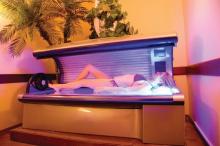User login
A large percentage of young white women use tanning beds or intentionally tan in the sun, despite repeated health warnings, according to a new survey from the American Academy of Dermatology.
"Our survey underscores the importance of educating young women about the very real risks of tanning," noted Dr. Ronald L. Moy, president of the AAD, in a statement.
The online survey of more than 3,800 white, non-Hispanic females aged 14 to 22 years, found that 81% of respondents had tanned outdoors frequently or occasionally in the past year. More than 32% reported using a tanning bed in the past year, while 25% reported using a tanning bed at least weekly.
Meanwhile, 86% of the respondents said that in the past year they never received a spray tan - the safe alternative to UV exposure.
When comparing ages, 18- to 22-year-old women were almost twice as likely (40%) to use indoor tanning beds, compared with 14 to 17 year olds (22%).
"The challenge is that teens have access to indoor tanning salons on almost every corner," noted Dr. Moy in his statement. "A recent survey of 116 U.S. cities found an average of 42 tanning salons per city, which means tanning salons are more prevalent than Starbucks or McDonald's."
Dr. James M. Spencer, of Mount Sinai School of Medicine, New York, was not surprised by the statistics. "It's a fashion," he said. "The media and advertisements make [being] tan desirable," and the media has more impact than physicians.
"We've been trying to get this message out of 20 years … But the public is headed in the wrong direction," said Dr. Spencer.
More than 1 million people in the U.S. tan in salons on an average day. White girls and women, particularly aged 16 to 29 years, make up almost 70% of tanning salon patrons, according to the AAD.
"We are very concerned that this tanning behavior will lead to a continued increase in the incidence of skin cancer in young people and, ultimately, more untimely deaths from this devastating disease," noted Dr. Moy.
Nearly 75% of skin cancer deaths are due to melanoma and rates have been rising over the last 30 years.
More than 30 states either prohibit or require parental consent for minors who want to use indoor tanning devices. The World Health Organization has declared UV radiation from the sun and artificial light sources a known carcinogen and has called for prohibiting minors from indoor tanning.
May has been designated Melanoma/Skin Cancer Detection and Prevention Month.
A large percentage of young white women use tanning beds or intentionally tan in the sun, despite repeated health warnings, according to a new survey from the American Academy of Dermatology.
"Our survey underscores the importance of educating young women about the very real risks of tanning," noted Dr. Ronald L. Moy, president of the AAD, in a statement.
The online survey of more than 3,800 white, non-Hispanic females aged 14 to 22 years, found that 81% of respondents had tanned outdoors frequently or occasionally in the past year. More than 32% reported using a tanning bed in the past year, while 25% reported using a tanning bed at least weekly.
Meanwhile, 86% of the respondents said that in the past year they never received a spray tan - the safe alternative to UV exposure.
When comparing ages, 18- to 22-year-old women were almost twice as likely (40%) to use indoor tanning beds, compared with 14 to 17 year olds (22%).
"The challenge is that teens have access to indoor tanning salons on almost every corner," noted Dr. Moy in his statement. "A recent survey of 116 U.S. cities found an average of 42 tanning salons per city, which means tanning salons are more prevalent than Starbucks or McDonald's."
Dr. James M. Spencer, of Mount Sinai School of Medicine, New York, was not surprised by the statistics. "It's a fashion," he said. "The media and advertisements make [being] tan desirable," and the media has more impact than physicians.
"We've been trying to get this message out of 20 years … But the public is headed in the wrong direction," said Dr. Spencer.
More than 1 million people in the U.S. tan in salons on an average day. White girls and women, particularly aged 16 to 29 years, make up almost 70% of tanning salon patrons, according to the AAD.
"We are very concerned that this tanning behavior will lead to a continued increase in the incidence of skin cancer in young people and, ultimately, more untimely deaths from this devastating disease," noted Dr. Moy.
Nearly 75% of skin cancer deaths are due to melanoma and rates have been rising over the last 30 years.
More than 30 states either prohibit or require parental consent for minors who want to use indoor tanning devices. The World Health Organization has declared UV radiation from the sun and artificial light sources a known carcinogen and has called for prohibiting minors from indoor tanning.
May has been designated Melanoma/Skin Cancer Detection and Prevention Month.
A large percentage of young white women use tanning beds or intentionally tan in the sun, despite repeated health warnings, according to a new survey from the American Academy of Dermatology.
"Our survey underscores the importance of educating young women about the very real risks of tanning," noted Dr. Ronald L. Moy, president of the AAD, in a statement.
The online survey of more than 3,800 white, non-Hispanic females aged 14 to 22 years, found that 81% of respondents had tanned outdoors frequently or occasionally in the past year. More than 32% reported using a tanning bed in the past year, while 25% reported using a tanning bed at least weekly.
Meanwhile, 86% of the respondents said that in the past year they never received a spray tan - the safe alternative to UV exposure.
When comparing ages, 18- to 22-year-old women were almost twice as likely (40%) to use indoor tanning beds, compared with 14 to 17 year olds (22%).
"The challenge is that teens have access to indoor tanning salons on almost every corner," noted Dr. Moy in his statement. "A recent survey of 116 U.S. cities found an average of 42 tanning salons per city, which means tanning salons are more prevalent than Starbucks or McDonald's."
Dr. James M. Spencer, of Mount Sinai School of Medicine, New York, was not surprised by the statistics. "It's a fashion," he said. "The media and advertisements make [being] tan desirable," and the media has more impact than physicians.
"We've been trying to get this message out of 20 years … But the public is headed in the wrong direction," said Dr. Spencer.
More than 1 million people in the U.S. tan in salons on an average day. White girls and women, particularly aged 16 to 29 years, make up almost 70% of tanning salon patrons, according to the AAD.
"We are very concerned that this tanning behavior will lead to a continued increase in the incidence of skin cancer in young people and, ultimately, more untimely deaths from this devastating disease," noted Dr. Moy.
Nearly 75% of skin cancer deaths are due to melanoma and rates have been rising over the last 30 years.
More than 30 states either prohibit or require parental consent for minors who want to use indoor tanning devices. The World Health Organization has declared UV radiation from the sun and artificial light sources a known carcinogen and has called for prohibiting minors from indoor tanning.
May has been designated Melanoma/Skin Cancer Detection and Prevention Month.

